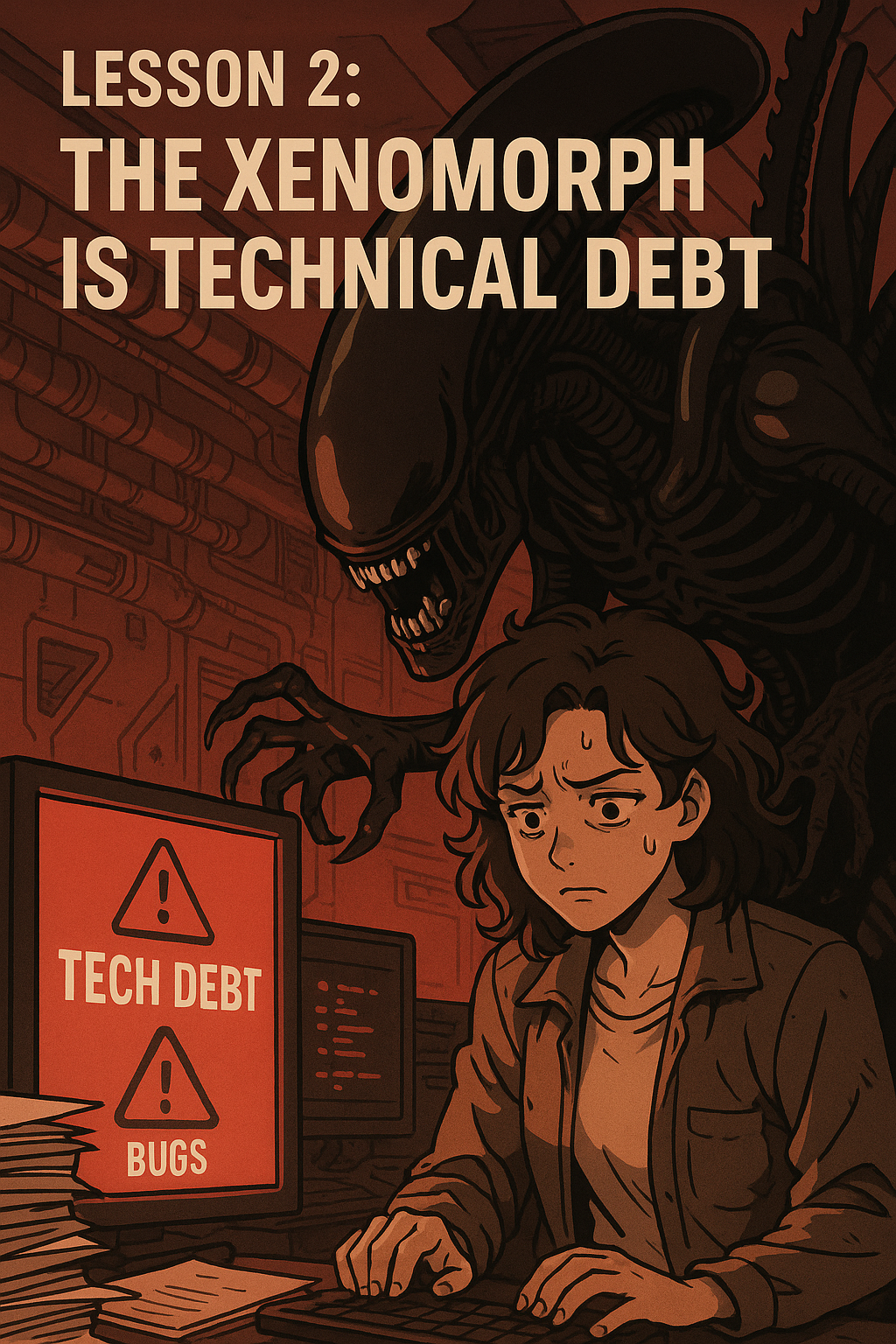Lesson 2: The Xenomorph Is Technical Debt

There’s a sound you learn to fear in management. It’s not the hiss of executives demanding “visibility.” It’s not the whisper of HR reminding you about “performance calibration.” It’s that quiet noise — like something moving in the walls.
That’s technical debt.
You can’t see it at first. The backlog looks clean. The sprint board is full of neat, digestible cards. Your engineers swear the last refactor “mostly worked.” The burndown chart even pretends you’re winning. And then something drops from the ceiling and punches a hole straight through your sprint velocity.
The Xenomorph is the perfect metaphor. Elegant. Efficient. Unstoppable. Technical debt doesn’t negotiate. It doesn’t respect your roadmap. It doesn’t care if you’re agile, lean, Kanban, or praying. It was born inside your system, it knows every crawlspace, and its only instinct is to grow teeth and feed.
Phase 1: The Egg
Technical debt starts innocent. A TODO comment tucked in a file. An untested branch merged “just to unblock.” A schema hack to make the demo run. A configuration parameter no one documents.
The egg just sits there. Quiet. Unassuming. Everyone sees it. Nobody touches it. “We’ll fix it later,” they say, and later never comes because later is a luxury management doesn’t allow.
But every egg is a promise. A cursed promise that one day it will open, and something will crawl out, and someone — maybe you — will have their face wrapped up in it.
You can hear your engineers say the lines:
- “It’s fine for now.”
- “We’ll come back to it.”
- “The deadline’s the priority.”
That’s not pragmatism. That’s the egg being incubated.
Phase 2: The Facehugger
The egg opens, and suddenly you’re face-to-face with an issue. The system is running, but no one understands why a hotfix worked. A dependency is pinned to a version three years old, and now security is screaming. A piece of infrastructure was hand-built by someone who left the company, and nobody dares touch it.
This is the facehugger phase. It doesn’t kill you right away. It latches on, feeds silently, keeps the system moving. But the price is inside you now. A timer has started.
Every standup is punctuated by these parasites:
- “We need to upgrade this, but it might break everything.”
- “Only Ravi knows how that service works, and he’s on PTO.”
- “That fix will take a full sprint, and leadership won’t approve it.”
As a manager, you smile and nod while knowing the truth: the facehugger is already down their throat, and your job is to act like it’s fine while you figure out how to not get blamed when the chestburster comes out.
Phase 3: The Chestburster
This is the day your project explodes.
You’re on track. You’re ready for a demo. You’ve promised leadership a delivery date. And then — splat. The system convulses. A small, sharp, screaming problem bursts right out of the plan.
Maybe a data migration fails and eats production. Maybe a dependency update shreds compatibility. Maybe a critical service is so tangled in debt that fixing one bug spawns five more.
Suddenly your sprint is nothing but gore. Engineers are covered in red tickets, screaming. Leadership wants answers. Your customers smell blood.
The chestburster is small, at first. Maybe you patch it. Maybe you think you can trap it. But you already know the truth. It’s not dying in this scene. It’s running loose, and it’s growing.
Phase 4: The Fully Grown Beast
Now you’re dealing with something you can’t control.
The system has a predator inside it. Technical debt that’s evolved beyond repair. Every fix is a risk. Every change is a potential catastrophe. Your velocity plummets because half your energy is spent just trying to avoid waking it up.
Your engineers start whispering:
- “We should rewrite this service.”
- “We can’t scale until we fix this.”
- “We need to invest in platform work.”
And you know they’re right. But you also know the Company — your Weyland-Yutani — doesn’t care. They’ll tell you: ship anyway. They’ll remind you that customers don’t pay for refactors. They’ll say, “We’ll address this later.”
Later never comes.
So you do what managers always do. You negotiate with the monster. You build rituals around avoiding its lair. You create runbooks, guardrails, tests — not to kill it, but to keep it fed just enough to not eat you alive.
The Ecosystem of Debt
It’s not just one alien. It’s a hive.
- Microservice Sprawl: Every team births their own pet alien, until your system is a colony of monsters all hissing at each other.
- Documentation Rot: Nobody writes anything down because the beast is moving too fast. Knowledge dies with attrition. The lair gets darker.
- Version Graveyards: Half your stack is pinned to end-of-life versions. Upgrading is suicide. Staying is suicide.
- Over-Optimized Hacks: Engineers who think cleverness is a virtue leave behind puzzles nobody else can solve.
The hive doesn’t sleep. Every shortcut is another egg. Every hack is another hiss in the walls. Every time leadership says “just get it done,” you know another chestburster is waiting.
The Manager’s Role in the Hive
Here’s the hard truth: as a manager, you don’t get to kill the Xenomorph. That fantasy belongs to slide decks and consultants.
Your role is darker. You’re the one keeping the crew alive long enough to maybe ship something before the system eats itself. You’re the one lying to the Company about how “sustainable” things are. You’re the one telling your engineers “we’ll fix it next sprint” while knowing you probably won’t.
You are not Ripley with a flamethrower. You are Dallas, crawling in the vents with a motion tracker, praying you can guide your team past the monster without getting someone ripped apart.
And sometimes, you are Ash, the android — forced to serve the Company’s orders, even if it means feeding your crew to the beast.
Strategies That Don’t Work (But We Pretend They Do)
- Debt Registers: You create a spreadsheet of every known alien. Congratulations. Now you have a catalog of your own impending death. The beast doesn’t care if it’s documented.
- “20% Refactor Time” Policies: Leadership loves this one. It sounds smart. It never works. That 20% is the first thing cut when deadlines hit.
- Big Bang Rewrite Dreams: Engineers beg for this. They want to nuke the site from orbit. The Company never lets them. It costs too much, takes too long, and by the time it’s done, you’ve just bred a new monster.
- OKRs About Stability: The Company asks you to measure the beast. As if you can attach KPIs to a nightmare. As if a graph will stop the claws.
Strategies That Actually Work (Sometimes)
- Containment Protocols: Build fences around the debt. Encapsulate the nightmare. Let it live in one place so it doesn’t infect the rest.
- Sacrificial Demos: Sometimes you sacrifice a sprint to feed the monster. You frame it as “platform investment” or “operational excellence” so leadership doesn’t realize you’re just keeping the beast from growing wings.
- Survivor Training: Teach your engineers to hear the hiss. Make them paranoid. Make them cautious. The best survival skill is knowing when not to poke the walls.
- The Airlock Option: Sometimes, you do kill it. You rip out a system, replace it, let the vacuum take the monster with it. But that costs blood, morale, and usually a few careers. It’s the last resort.
The Psychological Toll
Here’s the real management lesson: technical debt is not just technical. It’s emotional.
Living with the beast grinds people down.
- Engineers lose faith.
- Product managers lose patience.
- Leadership loses trust.
And you — the manager — lose sleep. You live in a permanent state of dread, knowing the backlog is a haunted house, every ticket a possible corpse.
You start speaking in code-switches:
- “We’re managing risk” (the alien is loose).
- “We’re aligning stakeholders” (the crew is panicking).
- “We’re deprecating systems” (we’re burning the nest and hoping nobody notices).
The truth is, you’re not managing people. You’re managing monsters.
The Inevitability of Failure
Let’s be honest. You don’t win against technical debt. You don’t kill the Xenomorph. You survive it.
The system will always breed new debt. Every deadline, every hack, every rushed feature is another egg. The Company will always push you to prioritize growth over stability. And sooner or later, the monster will take something from you: uptime, revenue, morale, sanity.
The best you can do is make the deaths meaningful. Sacrifice code, not people. Burn cycles, not trust. Open the airlock when you must, even if it means ejecting a system you loved.
Closing Hiss
If you’ve read this far, you know the truth: technical debt isn’t a bug, it’s the lifecycle. It starts as an egg. It ends as something tearing through your roadmap.
And as a manager, you’re not here to win. You’re here to last. To get your crew through one more sprint, one more release, one more quarter before the beast catches up.
Listen carefully. That’s the sound in the walls.
Hsssssssss.
The Xenomorph is already inside your system.
And it’s hungry.
